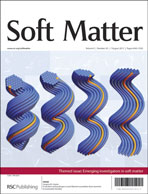The structure and rheology of sheared model swimmer suspensions
Abstract
We analyze the rheological response of a suspension of simple model swimmers subject to a steady Couette flow. We consider the squirmer model as a means to control systematically the interplay between self-propulsion and active stress generation and analyze their relative impact both on the effective viscosity of a suspension and the microstructure the squirmers develop. We show how self-propulsion introduces an intrinsic contribution to the effective viscosity of the active suspension. Accordingly, apolar squirmers show shear thickening while polar ones develop a shear thinning response to the applied shear. We show that the detailed coupling of the squirmers to the bounding walls has a strong influence on the structure of the suspension and the development of shear bands.

- This article is part of the themed collection: Emerging Investigators

 Please wait while we load your content...
Please wait while we load your content...